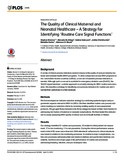| dc.contributor.author | Brenner, Stephan | |
| dc.contributor.author | Allegri, Manuela De | |
| dc.contributor.author | Gabrysch, Sabine | |
| dc.contributor.author | Chinkhumba, Jobiba | |
| dc.contributor.author | Sarker, Malabika | |
| dc.contributor.author | Muula, Adamson S. | |
| dc.date.accessioned | 2016-05-05T16:13:13Z | |
| dc.date.available | 2016-05-05T16:13:13Z | |
| dc.date.copyright | 2015 | |
| dc.date.issued | 2015-04-15 | |
| dc.identifier.citation | Brenner S, De Allegri M, Gabrysch S, Chinkhumba J, Sarker M, Muula AS (2015) The Quality of Clinical Maternal and Neonatal Healthcare – A Strategy for Identifying ‘Routine Care Signal Functions’. PLoS ONE 10(4): e0123968. doi:10.1371/ journal.pone.0123968 | en_US |
| dc.identifier.issn | 1932-6203 | |
| dc.identifier.uri | http://hdl.handle.net/10361/5236 | |
| dc.description | Includes bibliographical references (page 16-19). | |
| dc.description.abstract | Background
A variety of clinical process indicators exists to measure the quality of care provided by maternal
and neonatal health (MNH) programs. To allow comparison across MNH programs in
low- and middle-income countries (LMICs), a core set of essential process indicators is
needed. Although such a core set is available for emergency obstetric care (EmOC), the
‘EmOC signal functions’, a similar approach is currently missing for MNH routine care evaluation.
We describe a strategy for identifying core process indicators for routine care and illustrate
their usefulness in a field example.
Methods
We first developed an indicator selection strategy by combining epidemiological and programmatic
aspects relevant to MNH in LMICs. We then identified routine care process indicators
meeting our selection criteria by reviewing existing quality of care assessment
protocols. We grouped these indicators into three categories based on their main function in
addressing risk factors of maternal or neonatal complications. We then tested this indicator
set in a study assessing MNH quality of clinical care in 33 health facilities in Malawi.
Results
Our strategy identified 51 routine care processes: 23 related to initial patient risk assessment,
17 to risk monitoring, 11 to risk prevention. During the clinical performance assessment
a total of 82 cases were observed. Birth attendants’ adherence to clinical standards
was lowest in relation to risk monitoring processes. In relation to major complications, routine
care processes addressing fetal and newborn distress were performed relatively consistently,
but there were major gaps in the performance of routine care processes
addressing bleeding, infection, and pre-eclampsia risks.
Conclusion
The identified set of process indicators could identify major gaps in the quality of obstetric
and neonatal care provided during the intra- and immediate postpartum period.We hope
our suggested indicators for essential routine care processes will contribute to streamlining
MNH program evaluations in LMICs. | en_US |
| dc.description.statementofresponsibility | Stephan Brenner | |
| dc.description.statementofresponsibility | Manuela De Allegri | |
| dc.description.statementofresponsibility | Sabine Gabrysch | |
| dc.description.statementofresponsibility | Jobiba Chinkhumba | |
| dc.description.statementofresponsibility | Malabika Sarker | |
| dc.description.statementofresponsibility | Adamson S. Muula | |
| dc.format.extent | 19 pages | |
| dc.language.iso | en | en_US |
| dc.publisher | Plos One | en_US |
| dc.rights | BRAC University Journals are protected by copyright. They may be viewed from this source for any purpose, but reproduction or distribution in any format is prohibited without written permission. | |
| dc.title | The quality of clinical maternal and neonatal healthcare – a strategy for identifying ‘routine care signal functions’ | en_US |
| dc.type | Article | en_US |
| dc.contributor.department | James P Grant School of Public Health, BRAC University | |

